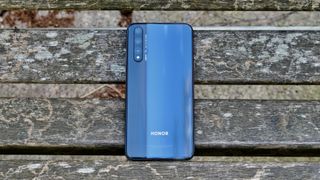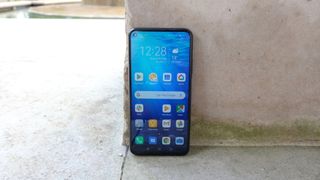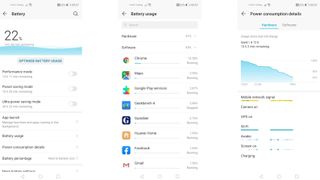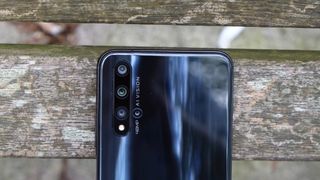
Honor 20 release date and price
- Out now
- Costs £400 (roughly $560, AU$810)
The best thing about the Honor 20 is that you’re getting a functionally high-end device for half the price of a true flagship. It has been possible to grab the Honor 20 in the UK since June 21, 2019 at a price of just £400 (roughly $560, AU$810).
That’s the same price as the Google Pixel 3a, which makes similar claims of offering flagship components for much less money. Unlike Google’s phone, the Honor 20 actually performs like a champ while offering a few concessions in the camera department.
The price also pitches the Honor 20 against a range of higher-end phones that have been discounted in recent months, such as the Nokia 9 PureView and the Xiaomi Mi 9.
Key features
- Great side-mounted fingerprint scanner
- Good hardware at a great price
- Quad-lens camera
Head over to the Honor website, and you’ll find that the brand considers the Honor 20’s quad camera system to be its headline feature.
We can see why Honor would go with such an eye-catching lead. But the Honor 20’s true USP is far less sexy: a general high-end level of hardware competence at a knock-down price.
It’s something that defines all of the cut-price Huawei sub-brand’s products, in fairness, and we doubt it will be making its way onto any product boxes. But that doesn’t make the Honor 20’s value proposition any less impressive.

For not a huge amount of money, you’re getting the same basic level of performance as you’ll find in the Huawei P30 Pro. You’re also getting the same rich 6.26-inch display as the pricier Honor 20 Pro. And of course, you’re getting that flashy quad-lens camera system.
However, one of our favorite features of the Honor 20 is something that would initially appear to be a quirky downgrade from its full-priced flagship rivals. Like the Honor 20 Pro, it has got a side-mounted fingerprint sensor embedded within its power key.
While other phones like the Samsung Galaxy S10 and the Huawei P30 Pro are opting for technically impressive yet fundamentally compromised in-display fingerprint scanners, the Honor 20 goes for a lower tech alternative that works way more quickly and effectively.

Unlocking your phone with a thumb or finger on the side of the phone feels surprisingly natural. In fact, it’s arguably even more natural than a rear or front-mounted solution, as it fits naturally into your grip.
Advertisement
You can also access it while the phone is flat on its back, unlike a rear-mounted sensor, yet it doesn’t necessitate an oversized chin like a classic front-mounted sensor.
We particularly appreciate how the power/authentication button has been fitted into a slight recess in the side, which helps you feel it out on the rare occasion when you don’t locate it instantly.
It’s also great how the phone wakes and unlocks with a light touch rather than a full press. And the process really is extremely fast and reliable.
Design
- Decent punch-hole design
- It’s a bit of a fingerprint magnet
The Honor 20 ticks most of the 2019 flagship design boxes, with a metal chassis constrained by glass to the rear and front.
On the front you have a terribly modern edge-to-edge display with a punch-hole notch in the top left corner. The rear has that expensive-looking reflective finish that throws light off in beautiful bands of color, even with the black model we tested.
This finish also makes the Honor 20 an absolute pig to photograph from the rear, though, without getting some crazy reflections. But you probably don’t care about that.

What you might care about is the fact that fingerprints stand out a mile with this particular glassy finish, and that it also makes the phone a rather slippery customer. Don’t set it down on anything shy of a dead-flat and super grippy surface, or it will go skidding away with minimal provocation.
The phone’s curved, matte metal sides help make it quite a pleasant handset to hold, even if those glass surfaces make things a little more precarious than we’d like. Thank goodness for that recessed power button/fingerprint scanner, which minimizes the need for shuffling the phone around in a single-handed grip.
Just above that power button is a rather less remarkable volume rocker, which is slightly more awkward to access. But it’s not a major issue.
There’s no 3.5mm headphone jack, unfortunately. It’s especially annoying that Honor hasn’t at least used this omission in the pursuit of an IP rating.
Display
- 6.26-inch LCD display is colorful
- 1080 x 2340 resolution
We’re rather fond of the Honor 20’s front-filling display. It’s plenty large enough at 6.26-inches, and plenty sharp enough at 1080 x 2340.
That’s not as pixel-packed as the QHD displays found in more expensive models, but there’s an argument to be made that such resolutions are overkill.
Advertisement

The picture is pleasingly balanced to our eyes, with vibrant colors and crisp whites. It does seem to lose a fair amount of its pop outdoors, however, suggesting that it doesn’t perhaps get quite as bright as the very best panels in the business.
It’s the same old unresolved story with that punch-hole element, though. That is, most video content (Netflix, Amazon Video) pretends it isn’t there and blocks it out, giving the phone a curious asymmetrical look. YouTube content can be zoomed in to fill the display, but you’ll generally lose some of the picture with that.
Most up-to-date games fit the 19.5:9 aspect ratio rather better, stretching right out to the edges of the screen. The effect is suitably immersive
Battery life
- 3,750mAh battery
- Good for two full days of moderate usage
Honor has slimmed down the battery offering from the Honor 20 Pro. A 3,750mAh unit is a little runtier than big brother’s 4,000mAh equivalent.
But it’s still more than up to the task. Honor/Huawei has been one of the best in the business when it comes to optimizing battery life in recent years, and the Honor 20 doesn’t let the side down.
With light to moderate usage, you could quite easily run through two full days in between charges. Even during a more hectic day involving lots of photo taking and a little game playing, we didn’t have to worry about finding a spare socket before bedtime. There was still plenty of juice left in the tank.

Playing lots of media will hit the battery hard, as with any phone. Our own test of a 90-minute looping 720p video with the brightness turned up to max sapped 17% on average, which isn’t particularly astounding. But nor is it remotely surprising - the Huawei P30 Pro lost 18% in the same test, even with its bigger battery.
The key here is that the Honor 20, like all Huawei phones, has been fine-tuned to be smart with its energy consumption in general conditions. It also packs in three power-saving modes of varying severity, and a help tool that will quickly identify where more savings could be made.
Even in the rare occasion that you find yourself short of power, Huawei’s generous inclusion of a 22.5W fast charger in the box will see you right. It’s good for a 0 to 50% charge in just 30 minutes.
Camera
- Quad-lens camera with 48MP main and 16MP super-wide lenses
- No telephoto lens, unlike the Pro
- Picture quality is generally very good
We’ve come to expect a lot from our smartphone cameras, to the point where the Honor 20’s quad-lens setup feels perilously close to being par for the course.
Let’s not kid ourselves, though: a 48MP main sensor with a fast f/1.8 aperture, accompanied by a 16MP super-wide-angle unit with an f/2.2 aperture, is pretty serious stuff at this price point.
The other two camera sensors aren’t quite as impressive in isolation, with a pair of 2MP f/2.4 units providing extra depth information and macro photography. What’s lost in all this, as the eagle-eyed will have spotted, is any kind of telephoto lens.

This is one of the more notable features dropped from the Honor 20 Pro package, and it results in disappointing zoom shots. You can still select 2x shots from the Camera UI, but it will just grab you a cropped image from the main sensor. And that means more noise.
That one disappointment aside (two if you count the rather superfluous macro camera), the main Honor 20 camera takes really good, vibrant pictures. Especially when you activate the AI camera mode, which will automatically pick out a scene’s characteristics and make appropriate tweaks and changes to the image processing.
In general, this leads to brighter, more vibrantly colorful shots. Blue skies look bluer, green fields greener, and everything just pops that little bit more. Occasionally this can tend towards the garish, but in general the results are very pleasing.

Switching to the wide-angle camera gives you an interesting new option, though there’s a noticeable drop in quality and shift in tone when you do.
The Honor 20’s AI mode also works well to rein in dynamic range, brightening shade and dimming extreme bright areas without making things look uncanny or false.
You’ll want to flick into Night Mode when things get really dim, though. It’s quite effective at pulling out extra detail in low light conditions, though you’ll need to hold on for a couple of seconds for the image to process.
The 32MP selfie camera, too, can capture sharp and balanced shots - though you’ll want to ignore those tacky Beauty effects. Yuck.
All in all, the Honor 20’s camera isn’t quite as much of a home run as its performance. But that’s mainly because of a certain Google Pixel 3a, which gives you a freakishly accomplished camera experience at a similar price. Of course, that phone also gives you some major performance compromises.
Interface and reliability
- Magic UI 2.1 is full of bloat and clutter
- Software is speedy and stable
The Honor 20 runs Magic UI 2.1, which is basically a different name for Huawei’s unloved EMUI.
As a result, software is comfortably the Honor 20’s weak point. We opted to set up the phone as a fresh install with none of our favorite apps receiving an automatic download. We could only laugh ruefully when we were confronted with the Honor 20’s initial home screen presentation.
Here were two home screens worth of superfluous, duplicate, derivative, or just plain ugly applications from Honor/Huawei. The only genuinely desirable ones come from Google, and most of them are crammed into a separate Google folder.

You also get Facebook pre-installed, which we can just about let pass. The Fortnite Installer icon also makes a certain amount of sense, as it’s one of the hottest games around whilst simultaneously being relatively tricky to locate. We have no idea why the Booking.com app is pre-installed, though.
Much of the app icon design takes on a sub-iOS look, and it’s clear that Huawei/Honor holds Apple’s OS in greater esteem than it does stock Android.
There’s just a sensation of naffness or cheapness to this brand of Android. It’s there in the little details, like the excruciatingly schmaltzy default ringtone.

We can’t deny that many of these aesthetic gripes fall away with prolonged exposure. As you customize the experience to your own tastes, tidying away the Huawei stuff, bringing the Google apps to the fore (and installing the likes of Google Keep and Calendar), and replacing the busy default keyboard with Google’s own, it all feels quite pleasant.
For all its faults, we can commend Magic UI/EMUI for one thing - it runs pretty smoothly. We barely picked up on a stutter or a glitch during our time with the Honor 20. Part of that is down to the phone’s speedy hardware. But credit where it’s due, the software plays a part here.
Movies, music and gaming
- 6.26-inch display is great for visual media
- Single bottom-mounted speaker isn’t ideal
- 128GB of internal storage but no microSD slot
The Honor 20 is a potent media-playing device with a lot going for it. Sure, there are bigger, sharper and more vibrant displays out there, but to get all three in one package you’d need to spend a fair bit more money - or content yourself with an outdated flagship.
There’s a pleasing sense of balance to the Honor 20’s display. Video content looks good on its 6.26-inch canvas, even if the handling of the punch-hole notch leaves much of it looking a little lopsided.
This is the ideal display for gaming content, too, which looks and moves great here.

It’s a shame that there’s only the one speaker on the bottom of the phone, and it’s rather too easy to cover up when playing landscape games. But this is far from unusual at this end of the market.
More damaging is the lack of a 3.5mm headphone jack. Honor does at least include a USB-C adaptor in the box, but it still feels like an annoying work-around.
One thing that the Honor 20 doesn’t lack is storage space for all that media. While there’s no microSD card slot here, you do get an ample 128GB of internal storage. That’s plenty.
Specs and benchmark performance
- Kirin 980 continues to impress
- Geekbench scores place it near the top of the mid-range tree
Advertisement
HiSilicon’s Kirin 980 chipset is one of the older members of the top-end crop, and it has been beaten by the likes of the Snapdragon 855.
But it still does the business in day to day usage, and it still produces the numbers to impress. Indeed, given that this is the same chip that powers the top-end Huawei P30 Pro - a phone which costs over twice as much - it’s even more impressive in the Honor 20.
With 6GB of RAM, the Honor 20 has 2GB less than the Honor 20 Pro. However, it’s more than good enough to run Android and advanced apps without a hitch.

Thanks to this speedy set-up, the Honor 20 blasts through any task you can throw at it. Things like rapid multitasking and windowed video content over a web browsing session didn’t so much as produce a stutter, while the fingerprint unlock process is nigh-on instantaneous.
High-end games, too, are no sweat for the Honor 20. PUBG defaults to high settings and runs like a dream, as does Asphalt 9.
Advertisement
Our Geekbench 4 benchmark tests confirm what we can sense with our own eyes and fingers. An average multi-core score of 9,645 trumps the 9,014 scored by the Nokia 9 PureView with its Snapdragon 845, and absolutely trounces the 5,070 scored by the Google Pixel 3a.
You’d generally need to spend hundreds more to get better performance from the likes of the Samsung Galaxy S10e - though the discounted Xiaomi Mi 9 is a notable exception. Even then, we doubt you’d notice without booting up the benchmark tests.
Verdict
The Honor 20 is another beautifully balanced, excellent value phone from the Huawei sub-brand. It’s extremely fast, well-designed, has a vibrant display, exemplary battery life, and a very capable quad-lens camera.
At £400 (around $560, AU$810), it’s a bit of a steal. However, while the hardware news is nearly all positive, there’s some concern over the Honor 20’s software.
Even placing the uncertainty surrounding all Huawei-linked smartphones aside for a moment, Magic UI remains an ugly mess of bloatware and needless tinkering.
It’s quite possible to mold it into something more pleasant to use, and it’s never less than fast and reliable. But this is an inferior experience to the stock - or near-stock - Android experiences of other similarly-priced phones.








Aucun commentaire:
Enregistrer un commentaire